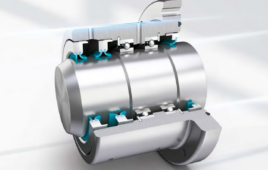An innovative new oil-drilling tool concept has seen the light of day.
The tool is being developed by researchers at SINTEF Petroleum Research, and it has characteristics that will enable it to take on a number of different tasks. One of these is to bring up oil from small oil-filled pockets that lie close to large fields on the continental shelf. Although any single pocket may seem to be insignificant, taken together they hold very valuable quantities of oil.
Extra set of teeth
The most important characteristic of the newly developed mole is very visible; it has one “row of teeth” more than other drilling tools.
Although the equipment as such is still on the drawing board, the researchers have used a 12 metre-long model of an oil-well to show how it will work by recreating the imprints – spiral grooves – that the extra teeth would leave in the wall of the well.
These grooves are the reason for the expectations that surround the new tool.
Oil-well with branches
Tests in the well model have shown that the grooves improve the efficiency of cleaning out the wellbore; i.e. the removal of drilling cuttings. Project manager Jan David Ytrehus of SINTEF explains that this offers a number of potential benefits:
“We believe that the new tool will make it easier to drill branches from existing wells out to nearby pockets of oil.”
Just how the cleaning of the “mole” can be utilised to achieve this is described below. But first, a little petroleum geology:
Cheaper drilling
The oil-bearing strata on the Norwegian shelf probably contain many thousands of small oil-filled pockets, and reservoir experts believe that we have just as much oil left out there as we have produced from all the major discovered fields together.
“If we explore and drill in the traditional manner, many small reservoirs will remain unprofitable and undisturbed. But if we can drill across to some more of them from existing wells, costs will be significantly reduced, and such “dwarf” reservoir close to the giants will become worth exploiting,” says Ytrehus, adding: “This will be a very efficient way of enhancing oil recovery rates.”
Equal to several sovereign wealth funds
One of Norway’s experts in petroleum research who is very interested in small unexploited reservoirs is Hans Borge, who directs the Department of Petroleum Technology at the University of Stavanger. Borge believes that the Norwegian continental shelf houses anywhere between 1000 and 100 000 pockets of hydrocarbons.
According to Borge, the greatest challenge lies in knowing exactly where these small deposits are to be found. He also points out that combined exploration and production wells will usually be a sensible strategy for Norway to adopt in the hunt for pockets of oil.
“Suppose that there are 10 000 such pockets. If we conservatively assume a price of USD 60 per barrel, these contain oil worth NOK 20 000 billion. Now that would be come to several “sovereign wealth funds”! But using traditional technology, it would easily need NOK 20 000 billion to produce that oil. And that is simply not realistic.
Valuable percentages
The department head estimates that one per cent of the pockets lie less than one kilometre from a reservoir from which we are already producing hydrocarbons.
“A single percentage may not sound like much, but there is good reason to believe that in that one per cent of pockets lies oil worth several hundred billion kroner. And no matter which Norwegian oil-field you are on, there will always be small unexploited reservoirs in the vicinity,” says Borge.
Teeth all around the drill-bit
If the new drilling tool meets the expectations raised by the laboratory results, Ytrehus believes that we could envisage drilling out to pockets up to a kilometre from current wells, if not even further.
But why should this new drilling tool be able to drill its way onwards from existing wells? And why is it difficult to do this using traditional equipment?
This illustration has numbered explanations.
1. All drilling for oil is based on the use of drilling fluid. This has several functions, among them cooling of the drill-bit.
2. The pressure of the drilling fluid also prevents the well from collapsing and allowing gas to flow into the wellbore during drilling. But it must not be too high; if it were, the drilling fluid would flow out of the well and disappear into the pores of the reservoir formation.
3. The drilling fluid is kept under a certain additional pressure in order to keep it circulating so that it carries the drill cuttings up to the surface. Traditional drilling requires such high extra pressure that a lot of drilling fluid would flow into depleted reservoirs if the branch wells were drilled from existing wells, so this potential method is insufficiently exploited.
4. The new drilling tool can get by with lower additional pressure than normal drilling equipment because its extra row of teeth (side-cutters) create spiral grooves in the wall of the well, which makes the removal of drilling cuttings more efficient.
5. Thanks to the low extra pressure, loss of drilling fluids becomes less of a problem, and this is what has given rise to hopes that the new tool can be used to drill out from existing wells.
Good reception
Project manager Jan David Ytrehus says the new tool has been given a good reception by both the offshore and service industries.
SINTEF intends to industrialise the new system by establishing a company for this purpose.
For more information visit www.sintef.com.
Filed Under: Industrial automation




